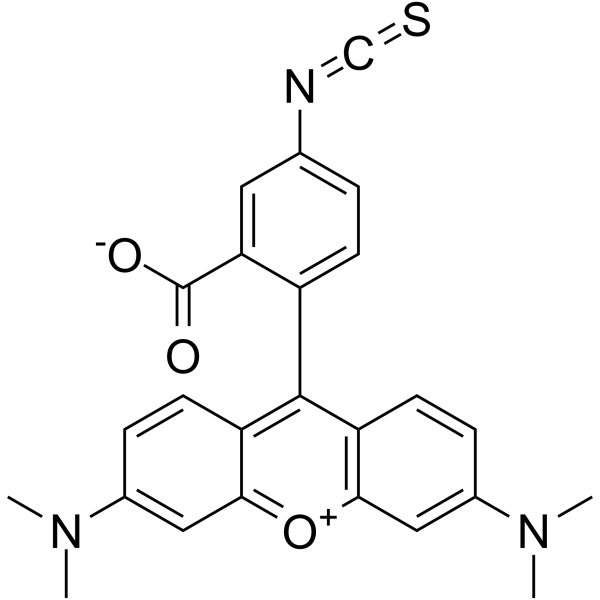Tetramethylrhodamine-5-isothiocyanate

Tetramethylrhodamine-5-isothiocyanate structure
|
Common Name | Tetramethylrhodamine-5-isothiocyanate | ||
|---|---|---|---|---|
| CAS Number | 80724-19-2 | Molecular Weight | 443.51800 | |
| Density | N/A | Boiling Point | N/A | |
| Molecular Formula | C25H21N3O3S | Melting Point | N/A | |
| MSDS | Chinese USA | Flash Point | N/A | |
Use of Tetramethylrhodamine-5-isothiocyanateTetramethylrhodamine-5-isothiocyanate is a potent fluorescent dye. Tetramethylrhodamine-5-isothiocyanate can be used for label PG-M3 antibody for rapid diagnosis of acute promyelocytic leukemia (APL). Tetramethylrhodamine-5-isothiocyanate can be used as probe to quantify in vivo the biodistribution of PLGA (poly(lactic-co-glycolic) acid) and PLGA/chitosan nanoparticles[1][2]. |
| Name | 2-[3-(dimethylamino)-6-dimethylazaniumylidenexanthen-9-yl]-5-isothiocyanatobenzoate |
|---|---|
| Synonym | More Synonyms |
| Description | Tetramethylrhodamine-5-isothiocyanate is a potent fluorescent dye. Tetramethylrhodamine-5-isothiocyanate can be used for label PG-M3 antibody for rapid diagnosis of acute promyelocytic leukemia (APL). Tetramethylrhodamine-5-isothiocyanate can be used as probe to quantify in vivo the biodistribution of PLGA (poly(lactic-co-glycolic) acid) and PLGA/chitosan nanoparticles[1][2]. |
|---|---|
| Related Catalog | |
| References |
| Molecular Formula | C25H21N3O3S |
|---|---|
| Molecular Weight | 443.51800 |
| Exact Mass | 443.13000 |
| PSA | 104.20000 |
| LogP | 4.76390 |
| Storage condition | -20°C |
| Personal Protective Equipment | Eyeshields;Gloves;type N95 (US);type P1 (EN143) respirator filter |
|---|---|
| Safety Phrases | S22;S24/25 |
| RIDADR | NONH for all modes of transport |
|
Resolving the infection process reveals striking differences in the contribution of environment, genetics and phylogeny to host-parasite interactions.
BMC Biol. 9 , 11, (2011) Infection processes consist of a sequence of steps, each critical for the interaction between host and parasite. Studies of host-parasite interactions rarely take into account the fact that different ... |
|
|
Migratory properties of naive, effector, and memory CD8(+) T cells.
J. Exp. Med. 194 , 953-66, (2001) It has been proposed that two different antigen-experienced T cell subsets may be distinguishable by their preferential ability to home to lymphoid organs (central memory cells) or nonlymphoid tissues... |
|
|
Basic fibroblast growth factor in the bone microenvironment enhances cell motility and invasion of Ewing's sarcoma family of tumours by activating the FGFR1-PI3K-Rac1 pathway.
Br. J. Cancer 103 , 370-81, (2010) Ewing's sarcoma family of tumours (ESFT) is a malignant small round-cell tumour of the bone and soft tissues. It is characterised by a strong tendency to invade and form metastases. The microenvironme... |
| Xanthylium |
| Tetramethylrhodamine-5-isothiocyanate |
| 5-TRITC |
| 5-TRITC,G isomer |
| MFCD00467978 |